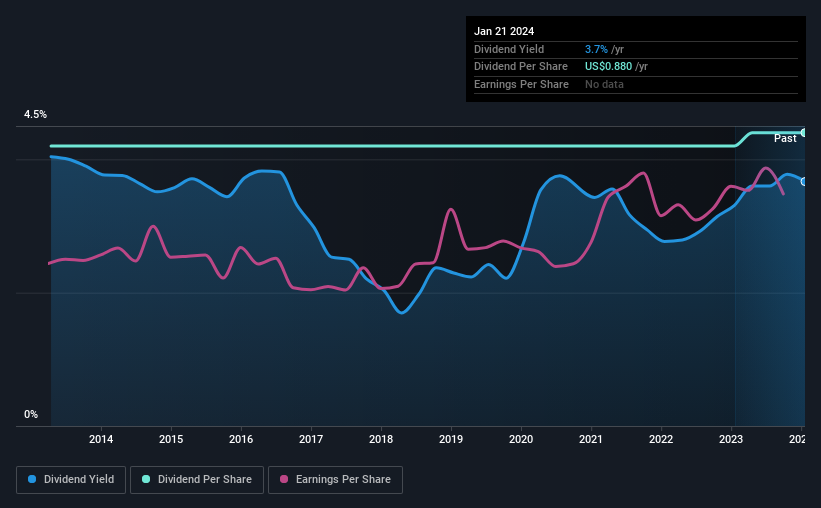Ohio Valley Banc Corp. (NASDAQ:OVBC) Looks Like A Good Stock, And It's Going Ex-Dividend Soon
It looks like Ohio Valley Banc Corp. (NASDAQ:OVBC) is about to go ex-dividend in the next three days. The ex-dividend date is one business day before the record date, which is the cut-off date for shareholders to be present on the company's books to be eligible for a dividend payment. The ex-dividend date is an important date to be aware of as any purchase of the stock made on or after this date might mean a late settlement that doesn't show on the record date. In other words, investors can purchase Ohio Valley Banc's shares before the 25th of January in order to be eligible for the dividend, which will be paid on the 10th of February.
The company's upcoming dividend is US$0.22 a share, following on from the last 12 months, when the company distributed a total of US$0.88 per share to shareholders. Based on the last year's worth of payments, Ohio Valley Banc stock has a trailing yield of around 3.7% on the current share price of $24. If you buy this business for its dividend, you should have an idea of whether Ohio Valley Banc's dividend is reliable and sustainable. That's why we should always check whether the dividend payments appear sustainable, and if the company is growing.
Check out our latest analysis for Ohio Valley Banc
If a company pays out more in dividends than it earned, then the dividend might become unsustainable - hardly an ideal situation. Ohio Valley Banc paid out a comfortable 32% of its profit last year.
Companies that pay out less in dividends than they earn in profits generally have more sustainable dividends. The lower the payout ratio, the more wiggle room the business has before it could be forced to cut the dividend.
Click here to see how much of its profit Ohio Valley Banc paid out over the last 12 months.
Have Earnings And Dividends Been Growing?
Companies with consistently growing earnings per share generally make the best dividend stocks, as they usually find it easier to grow dividends per share. If earnings decline and the company is forced to cut its dividend, investors could watch the value of their investment go up in smoke. For this reason, we're glad to see Ohio Valley Banc's earnings per share have risen 11% per annum over the last five years.
Another key way to measure a company's dividend prospects is by measuring its historical rate of dividend growth. Ohio Valley Banc's dividend payments are broadly unchanged compared to where they were 10 years ago.
The Bottom Line
Is Ohio Valley Banc an attractive dividend stock, or better left on the shelf? Typically, companies that are growing rapidly and paying out a low fraction of earnings are keeping the profits for reinvestment in the business. This is one of the most attractive investment combinations under this analysis, as it can create substantial value for investors over the long run. Ohio Valley Banc ticks a lot of boxes for us from a dividend perspective, and we think these characteristics should mark the company as deserving of further attention.
Keen to explore more data on Ohio Valley Banc's financial performance? Check out our visualisation of its historical revenue and earnings growth.
A common investing mistake is buying the first interesting stock you see. Here you can find a full list of high-yield dividend stocks.
Have feedback on this article? Concerned about the content? Get in touch with us directly. Alternatively, email editorial-team (at) simplywallst.com.
This article by Simply Wall St is general in nature. We provide commentary based on historical data and analyst forecasts only using an unbiased methodology and our articles are not intended to be financial advice. It does not constitute a recommendation to buy or sell any stock, and does not take account of your objectives, or your financial situation. We aim to bring you long-term focused analysis driven by fundamental data. Note that our analysis may not factor in the latest price-sensitive company announcements or qualitative material. Simply Wall St has no position in any stocks mentioned.

 Yahoo Finance
Yahoo Finance 
